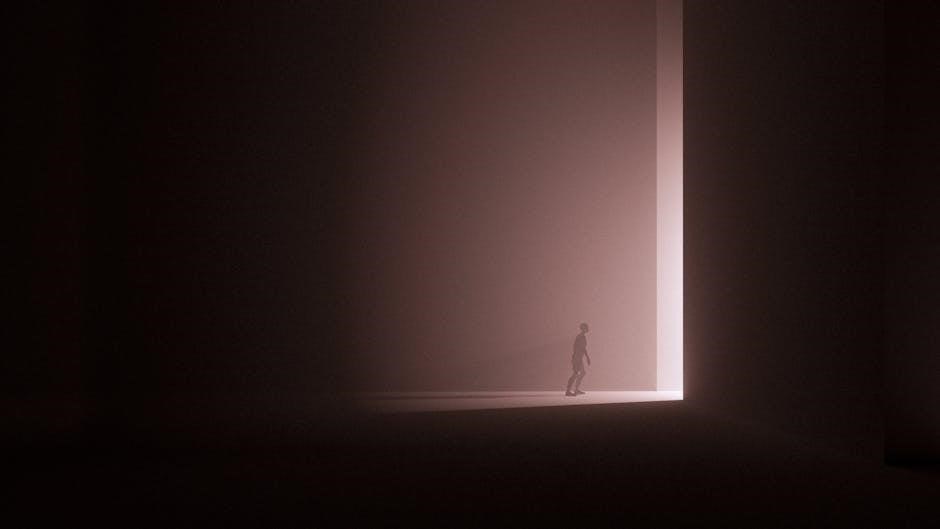A motion sensor light switch with manual override combines automation and user control, offering convenience and security. It integrates advanced PIR or microwave technology with a traditional switch.
Overview of Motion Sensor Light Switches
Motion sensor light switches automatically control lighting based on occupancy, enhancing convenience and energy efficiency. They use technologies like PIR or microwave sensors to detect movement. These switches often include manual override options, allowing users to bypass automation when needed. They are ideal for spaces requiring hands-free operation, such as hallways or bathrooms. By integrating smart features like timers and sensitivity adjustments, they provide a seamless blend of automation and user control, making them a popular choice for modern homes and commercial settings.
Importance of Manual Override in Lighting Control
Manual override in lighting control provides flexibility, allowing users to bypass automated settings when needed. This feature is crucial for preventing false triggers and ensuring consistent lighting. It enables manual activation or deactivation of lights, offering reliability in situations where motion sensors may fail. By combining automation with manual control, users gain the best of both worlds, ensuring energy efficiency and convenience. This dual functionality enhances user satisfaction and adapts to various lighting needs, making it a vital component of modern lighting systems.

What is a Motion Sensor Light Switch?

A motion sensor light switch automatically controls lighting based on detected movement, combining convenience with energy efficiency. It integrates manual override for user flexibility and control.

Definition and Basic Functionality
A motion sensor light switch is a device that automatically controls lighting based on detected movement. It uses technologies like passive infrared (PIR) or microwave sensors to detect motion and trigger lighting changes. The basic functionality involves turning lights on when motion is detected and off after a set period of inactivity. This switch also includes a manual override feature, allowing users to bypass automatic settings for direct control. The combination of automation and manual control enhances convenience, security, and energy efficiency in various lighting applications.

Types of Motion Sensors (PIR, Microwave, etc.)
Motion sensors are categorized into types based on their detection technology. Passive Infrared (PIR) sensors detect heat and movement within their field of view, making them widely used for their reliability and cost-effectiveness. Microwave sensors emit high-frequency waves and detect disruptions caused by moving objects, offering superior range and accuracy. Dual-tech sensors combine PIR and microwave technologies to reduce false triggers. Each type has unique advantages, catering to different environments and lighting control needs, ensuring efficient and tailored automation solutions.
Key Features of Motion Sensor Light Switches
Motion sensor light switches offer automated lighting control, manual override options, adjustable sensitivity, and customizable timer settings, enhancing convenience, security, and energy efficiency seamlessly.
Automatic Lighting Control
Automatic lighting control is a core feature of motion sensor switches, enabling lights to turn on/off based on detected movement. This eliminates manual operation, saving effort and energy. Advanced sensors use PIR or microwave technology to detect motion accurately. Adjustable sensitivity ensures lights activate only when needed, preventing false triggers. Timers can be set to keep lights on for a specific duration after motion ceases. This seamless operation enhances convenience and security in homes and public spaces effectively.
Manual Override Capability
Manual override capability allows users to bypass automation, enabling direct control of lighting. This feature is essential for scenarios where motion detection may fail or when consistent lighting is required. By flipping a switch, users can override the sensor, ensuring lights stay on or off as needed. This functionality enhances flexibility and reliability, addressing situations like false triggers or failed sensors. It provides peace of mind and seamless integration with smart lighting systems, making it a vital component for modern lighting solutions.
Adjustable Sensitivity and Timer Settings
Adjustable sensitivity ensures the sensor detects motion accurately, minimizing false triggers. Timer settings allow customization of how long lights stay on after motion ceases. Users can fine-tune these features to suit their preferences, enhancing efficiency and convenience. This adaptability ensures the system operates reliably, providing consistent lighting while conserving energy. By adjusting sensitivity and timers, users can optimize performance for specific spaces, ensuring the light switch functions precisely as needed without unnecessary activations or prolonged operation. This feature-rich design improves overall user experience and system reliability.
How Motion Sensor Light Switches Work
Motion sensor light switches detect movement using infrared or microwave technology. They process signals to activate lights automatically, ensuring efficient and hands-free illumination when motion is detected nearby.
Passive Infrared (PIR) Technology
Passive Infrared (PIR) sensors detect motion by monitoring infrared radiation emitted by objects. When a person enters the sensor’s range, the temperature change triggers the switch, activating the light. PIR sensors are commonly installed in corners for wide coverage. They are energy-efficient and reliable, though they may occasionally false trigger due to pets or drafts. Adjustable sensitivity settings help customize detection accuracy. This technology seamlessly integrates with manual override features, allowing users to switch between automated and manual lighting control as needed.
Microwave Sensor Technology

Microwave sensors emit low-power microwave signals, detecting motion through changes in wave reflection. They offer strong penetration through walls or obstacles, ensuring reliable motion detection. Unlike PIR sensors, microwaves are less affected by environmental factors, reducing false triggers. These sensors are often used in industrial settings but can also enhance home lighting systems. When paired with manual override, they provide robust control, allowing users to switch between automatic and manual modes seamlessly. This dual functionality ensures both convenience and reliability in lighting management.
Integration with Manual Override Mechanism
The integration of manual override with motion sensors allows users to switch between automatic and manual lighting control seamlessly. This mechanism ensures flexibility, enabling users to override the sensor’s detection when needed. The override feature is typically achieved through a physical switch or digital interface, providing direct control over lighting. This combination enhances convenience, especially in scenarios requiring continuous illumination. The system’s design ensures smooth transitions between modes, maintaining energy efficiency while offering user preference. This integration is a key feature in modern lighting solutions.


Installation and Wiring Requirements
Installing a motion sensor light switch requires connecting live, neutral, and load wires. Ensure proper wiring to avoid system malfunctions and ensure safe operation.
Understanding Live, Neutral, and Load Wires
Live wires carry the electrical current, while neutral wires complete the circuit. The load wire connects to the light fixture. Proper identification and connection are crucial for safe installation.
Step-by-Step Installation Guide
Turn off the power supply at the circuit breaker. 2. Remove the old switch and connect the live, neutral, and load wires to the new sensor switch. 3. Mount the sensor securely, ensuring optimal coverage. 4. Restore power and test functionality. Proper wiring ensures safe and efficient operation.
Common Wiring Issues and Solutions
One common issue is the absence of a neutral wire, essential for motion sensors. Solutions include verifying wiring diagrams or consulting electricians. Misconnecting load and live wires can cause malfunctions. Correcting this ensures proper operation. Additionally, faulty ground wires may lead to sensor inaccuracy. Ensuring all connections are secure and correctly routed resolves most issues. Proper wiring is crucial for reliable performance and safety. Always follow manufacturer guidelines to avoid such problems.

Benefits of Using Motion Sensor Light Switches
Motion sensor light switches enhance energy efficiency, reduce manual operation, and boost security. They offer convenience, extend bulb life, and lower electricity costs with smart automation.
Energy Efficiency and Cost Savings
Motion sensor light switches significantly reduce energy waste by automatically turning off lights when no presence is detected. This smart operation lowers electricity bills and minimizes unnecessary consumption. By eliminating manual oversight, these switches ensure lights are only active when needed, extending bulb life. Their ability to adapt to occupancy patterns makes them a cost-effective solution for homes and businesses, promoting sustainable energy use while maintaining convenience and functionality.
Enhanced Convenience and Security
Motion sensor light switches with manual override offer unparalleled convenience by automatically controlling lighting based on presence, eliminating the need for manual operation. This feature is especially beneficial in high-traffic areas like hallways or bathrooms. Additionally, these switches enhance security by providing sudden illumination when motion is detected, deterring potential intruders. The manual override ensures users can bypass automation when needed, offering a reliable and flexible lighting solution that balances smart operation with personal control.
Longer Bulb Life Due to Smart Operation
Motion sensor light switches with manual override extend bulb life by minimizing unnecessary usage. Smart operation ensures lights activate only when needed, reducing wear and tear. This energy-efficient approach leads to significant cost savings over time. The ability to manually override further enhances control, allowing users to customize lighting usage. By combining automation and manual intervention, these switches promote longer bulb longevity and system reliability, making them a practical and sustainable lighting solution.

Troubleshooting Common Issues
Common issues include frequent false triggers, failed manual override, and system failures. These are often resolved by adjusting sensitivity, checking wiring, or replacing faulty components.
Frequent False Triggers
False triggers occur when sensors detect unintended movement, such as pets or drafts. Adjusting sensitivity settings can minimize these occurrences. Ensure the sensor is mounted correctly and away from direct sunlight or heat sources, as infrared interference may cause malfunctions. Regularly cleaning the sensor lens can also improve accuracy. If issues persist, consider updating the sensor technology or consulting a professional for wiring checks. Proper calibration ensures reliable performance.
Failed Manual Override Function
If the manual override fails, the switch may not respond to physical toggling. Check wiring connections, ensuring live, neutral, and load wires are securely attached. Faulty switches or worn contacts can cause override failures. Resetting the device by disconnecting power for 30 seconds may resolve issues. If problems persist, replacing the switch or consulting an electrician is recommended. Ensure compatibility with existing lighting systems to maintain functionality. Regular maintenance can prevent such failures.
Complete System Failure
A complete system failure occurs when both motion sensing and manual override functions stop working. This could be due to power supply issues, faulty wiring, or damaged components. Check the circuit breaker and ensure all connections are secure. Verify that live, neutral, and load wires are correctly linked. If the issue persists, the sensor or switch may need replacement. Resetting the device by disconnecting power temporarily can sometimes resolve the problem. Ensure all components are compatible and functioning properly. Consult a licensed electrician if the failure is irreversible.
Motion sensor light switches with manual override offer a blend of automation, efficiency, and user control, making them a practical and innovative solution for modern lighting needs.
Final Thoughts on Motion Sensor Light Switches
Motion sensor light switches with manual override are a practical and efficient solution for modern lighting needs. They combine automation with user control, enhancing convenience and energy efficiency. These switches are ideal for various settings, from homes to commercial spaces, offering reliable performance and customization. Their ability to adapt to different environments ensures they meet diverse user preferences. As technology advances, their integration with smart systems further solidifies their role in creating intelligent, user-friendly lighting solutions.
Future Trends in Smart Lighting Technology
The future of motion sensor light switches lies in seamless integration with smart home systems, enabling voice control and advanced automation. Expect enhanced compatibility with platforms like Alexa and Google Home, allowing users to customize lighting scenarios effortlessly. Energy efficiency will improve through adaptive learning algorithms that optimize power usage based on occupancy patterns. Additionally, health-focused features like circadian lighting may emerge, aligning indoor lighting with natural daylight to enhance well-being. These innovations will redefine lighting convenience and efficiency in smart spaces.

No Responses